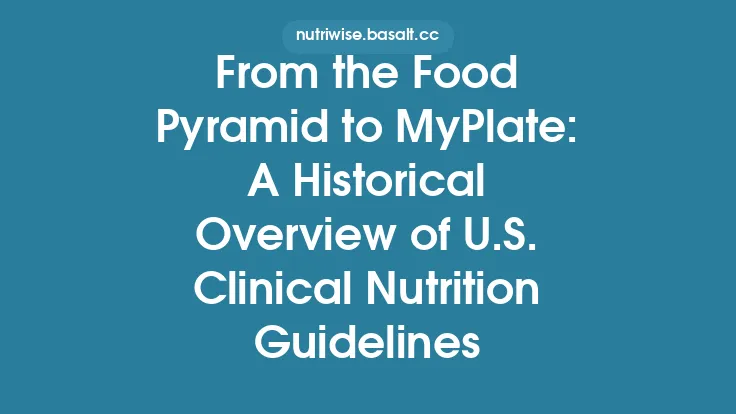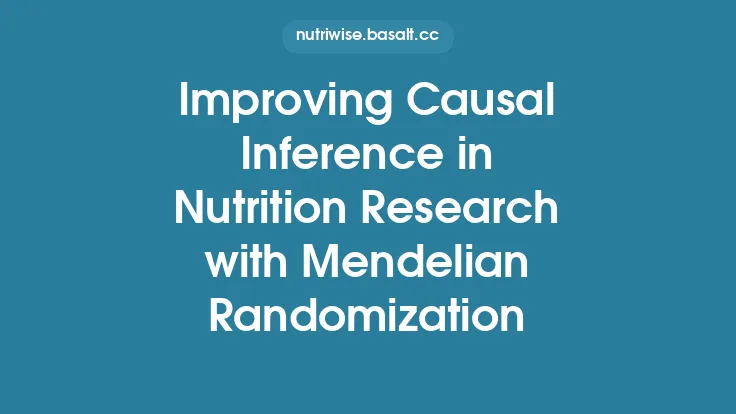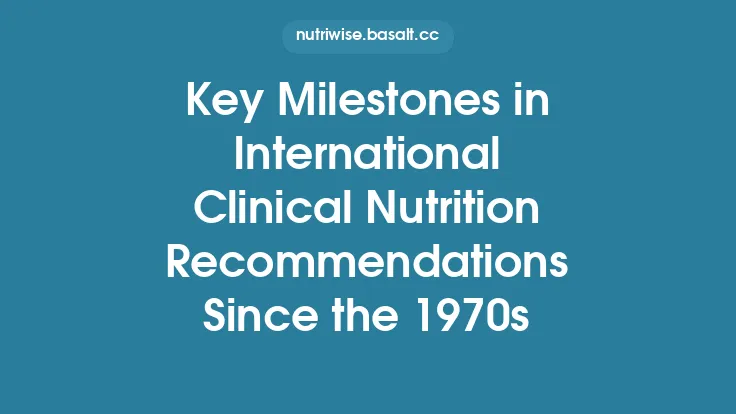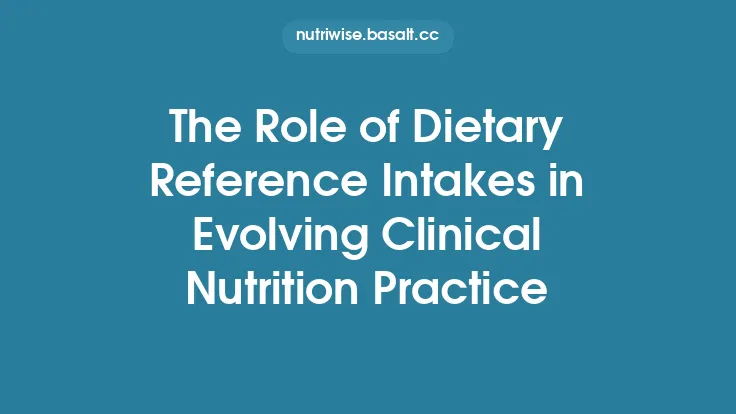Modern clinical nutrition guidelines are no longer the product of expert opinion alone; they are the culmination of rigorous, evidence‑based research that translates scientific findings into practical recommendations for patient care. This transformation has been driven by methodological advances, systematic synthesis of data, and transparent grading of evidence. Below is an in‑depth exploration of how contemporary research practices shape the guidelines that clinicians rely on today.
The Foundations of Evidence‑Based Nutrition
1. Hierarchy of Evidence in Nutrition Science
Nutrition research, like other biomedical fields, adheres to a hierarchy that ranks study designs by their ability to infer causality. At the apex sit well‑designed randomized controlled trials (RCTs) and meta‑analyses of such trials, followed by controlled clinical trials, prospective cohort studies, case‑control studies, cross‑sectional surveys, and finally mechanistic or animal studies. Modern guideline panels prioritize data from the upper tiers while still considering lower‑tier evidence when higher‑quality data are unavailable.
2. Systematic Reviews and Meta‑Analyses
Systematic reviews provide a structured, reproducible method for identifying, appraising, and synthesizing all relevant literature on a specific nutrition question. Meta‑analysis, when appropriate, aggregates effect sizes across studies, increasing statistical power and allowing for subgroup analyses (e.g., age, disease severity). The Cochrane Collaboration and the Nutrition Evidence Library are two prominent repositories that supply high‑quality systematic reviews used as the backbone of guideline development.
3. The GRADE Framework
Guideline Development and Evaluation (GRADE) is now the de‑facto standard for rating the certainty of evidence and the strength of recommendations. GRADE evaluates five domains—risk of bias, inconsistency, indirectness, imprecision, and publication bias—to assign a certainty level (high, moderate, low, very low). This transparent approach ensures that clinicians understand not only *what is recommended but also why* the recommendation carries a particular weight.
Translating Evidence into Guideline Statements
1. Defining Clinical Questions with PICO
Guideline panels formulate each recommendation around a PICO (Population, Intervention, Comparator, Outcome) question. For example: “In adult patients with severe burns (Population), does high‑protein enteral nutrition (Intervention) compared with standard protein provision (Comparator) improve wound healing (Outcome)?” This precise framing guides literature searches and evidence appraisal.
2. Evidence Synthesis and Consensus Building
After gathering relevant studies, expert panels conduct evidence tables that summarize study characteristics, effect estimates, and GRADE assessments. Deliberations often involve Delphi processes or nominal group techniques to achieve consensus while minimizing individual bias. The resulting statements are phrased to reflect both the direction of effect and the certainty of evidence (e.g., “We recommend…,” “We suggest…”).
3. Addressing Heterogeneity and Subgroup Effects
Nutrition interventions frequently exhibit heterogeneity due to variations in baseline nutritional status, disease state, and delivery method (enteral vs. parenteral). Modern guidelines incorporate subgroup analyses when the evidence supports differential effects. For instance, protein targets may be stratified by catabolic stress level, with higher recommendations for critically ill patients exhibiting hypermetabolism.
Key Areas Where Evidence Has Reshaped Modern Recommendations
1. Protein Provision in Critical Illness
Early RCTs and subsequent meta‑analyses have demonstrated that delivering 1.2–2.0 g kg⁻¹ day⁻¹ of protein to critically ill patients reduces muscle loss and improves functional outcomes. The GRADE assessment for this evidence is moderate to high, leading to strong recommendations for higher protein targets in intensive care units (ICUs) compared with the historical “0.8 g kg⁻¹ day⁻¹” standard.
2. Micronutrient Supplementation in Specific Populations
Evidence from large, multicenter RCTs has clarified the role of vitamin D, selenium, and zinc in immune modulation and wound healing. For example, a pooled analysis of 12 RCTs showed that vitamin D supplementation (≥2000 IU/day) in patients with severe deficiency reduces infection rates in postoperative settings (RR 0.78, 95% CI 0.65–0.93). Such data have prompted conditional recommendations for routine screening and targeted supplementation in high‑risk groups.
3. Enteral vs. Parenteral Nutrition Timing
Systematic reviews comparing early (<24 h) versus delayed initiation of enteral nutrition in mechanically ventilated patients have consistently shown reduced infection rates and shorter ICU stays with early enteral feeding (RR 0.71, 95% CI 0.58–0.87). The high certainty of evidence has resulted in strong guideline statements favoring early enteral nutrition when the gastrointestinal tract is functional.
4. Use of Disease‑Specific Nutrient Formulas
Meta‑analyses of disease‑specific formulas (e.g., immune‑modulating formulas enriched with arginine, omega‑3 fatty acids, and nucleotides) in patients with severe trauma or sepsis have demonstrated modest but statistically significant reductions in length of stay and mortality. The evidence, graded as moderate, supports conditional recommendations for these formulas in select patient cohorts.
Methodological Innovations Strengthening the Evidence Base
1. Adaptive Trial Designs
Adaptive designs allow interim analyses to modify sample size, dosing, or inclusion criteria without compromising statistical integrity. Recent adaptive RCTs in nutrition have accelerated the identification of optimal protein dosing in renal replacement therapy, providing high‑quality data that feed directly into guideline updates.
2. Network Meta‑Analysis (NMA)
NMA extends traditional meta‑analysis by simultaneously comparing multiple interventions, even when head‑to‑head trials are lacking. For example, an NMA of various lipid emulsions (soybean oil, fish oil, olive oil) has clarified relative risks of hepatic dysfunction, informing nuanced recommendations on lipid selection in parenteral nutrition.
3. Real‑World Evidence (RWE) Integration
Large electronic health record (EHR) databases now enable the extraction of real‑world nutrition outcomes. Propensity‑matched cohort studies using RWE have corroborated RCT findings on protein dosing, enhancing confidence in guideline applicability across diverse clinical settings.
Ensuring Transparency and Minimizing Bias
1. Conflict‑of‑Interest Management
Guideline panels now require full disclosure of financial and intellectual conflicts. Independent methodological reviewers audit the evidence synthesis process, and any potential bias is documented in the guideline’s public report.
2. Public Comment and Peer Review
Draft recommendations are posted for public comment, allowing clinicians, researchers, and patient advocacy groups to provide feedback. Peer review by external experts further refines the statements before final publication.
3. Updating Cycles and Living Guidelines
Given the rapid expansion of nutrition research, many organizations have adopted “living guideline” models. These are continuously updated as new high‑quality evidence emerges, ensuring that recommendations remain current without waiting for the traditional 3–5‑year revision cycle.
The Impact of Evidence‑Based Guidelines on Clinical Practice
1. Standardization of Care
Evidence‑based guidelines reduce practice variability by providing clear, actionable targets (e.g., protein grams per kilogram, timing of nutrition initiation). This standardization improves patient outcomes and facilitates benchmarking across institutions.
2. Education and Training
Guidelines serve as core curricula for dietitians, physicians, and allied health professionals. Structured educational modules based on guideline content enhance competency in nutrition assessment and intervention.
3. Quality Metrics and Reimbursement
Healthcare systems increasingly tie quality metrics—such as adherence to protein targets or early enteral nutrition—to reimbursement models. Evidence‑based guidelines thus directly influence financial incentives and resource allocation.
Challenges and Future Directions in Evidence Integration
While the focus of this article is on the current evidence‑based framework, it is worth noting ongoing challenges that shape the evolution of guidelines:
- Heterogeneity of Study Populations: Many nutrition trials enroll relatively homogenous cohorts, limiting generalizability. Future research must prioritize diverse populations to broaden guideline applicability.
- Biomarker Development: Reliable biomarkers of nutritional status (e.g., sarcopenia indices, metabolomic signatures) are needed to refine outcome measures and personalize recommendations.
- Implementation Science: Translating guideline recommendations into routine practice requires robust implementation strategies, including decision support tools integrated within EHRs.
By continuously refining research methodologies, embracing transparent evidence appraisal, and fostering collaborative guideline development, the field of clinical nutrition ensures that recommendations remain scientifically sound, clinically relevant, and ultimately beneficial for patient health.





